Babak Damavandi
Proactive Assistant Dialogue Generation from Streaming Egocentric Videos
Jun 06, 2025Abstract:Recent advances in conversational AI have been substantial, but developing real-time systems for perceptual task guidance remains challenging. These systems must provide interactive, proactive assistance based on streaming visual inputs, yet their development is constrained by the costly and labor-intensive process of data collection and system evaluation. To address these limitations, we present a comprehensive framework with three key contributions. First, we introduce a novel data curation pipeline that synthesizes dialogues from annotated egocentric videos, resulting in \dataset, a large-scale synthetic dialogue dataset spanning multiple domains. Second, we develop a suite of automatic evaluation metrics, validated through extensive human studies. Third, we propose an end-to-end model that processes streaming video inputs to generate contextually appropriate responses, incorporating novel techniques for handling data imbalance and long-duration videos. This work lays the foundation for developing real-time, proactive AI assistants capable of guiding users through diverse tasks. Project page: https://pro-assist.github.io/
PerceptionLM: Open-Access Data and Models for Detailed Visual Understanding
Apr 17, 2025



Abstract:Vision-language models are integral to computer vision research, yet many high-performing models remain closed-source, obscuring their data, design and training recipe. The research community has responded by using distillation from black-box models to label training data, achieving strong benchmark results, at the cost of measurable scientific progress. However, without knowing the details of the teacher model and its data sources, scientific progress remains difficult to measure. In this paper, we study building a Perception Language Model (PLM) in a fully open and reproducible framework for transparent research in image and video understanding. We analyze standard training pipelines without distillation from proprietary models and explore large-scale synthetic data to identify critical data gaps, particularly in detailed video understanding. To bridge these gaps, we release 2.8M human-labeled instances of fine-grained video question-answer pairs and spatio-temporally grounded video captions. Additionally, we introduce PLM-VideoBench, a suite for evaluating challenging video understanding tasks focusing on the ability to reason about "what", "where", "when", and "how" of a video. We make our work fully reproducible by providing data, training recipes, code & models.
Doppelgänger's Watch: A Split Objective Approach to Large Language Models
Sep 09, 2024Abstract:In this paper, we investigate the problem of "generation supervision" in large language models, and present a novel bicameral architecture to separate supervision signals from their core capability, helpfulness. Doppelg\"anger, a new module parallel to the underlying language model, supervises the generation of each token, and learns to concurrently predict the supervision score(s) of the sequences up to and including each token. In this work, we present the theoretical findings, and leave the report on experimental results to a forthcoming publication.
SnapNTell: Enhancing Entity-Centric Visual Question Answering with Retrieval Augmented Multimodal LLM
Mar 07, 2024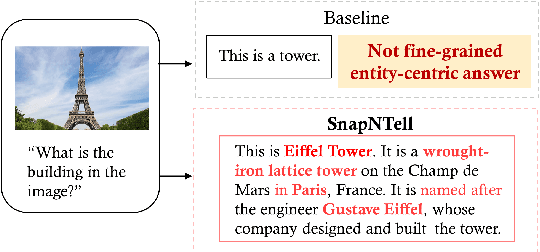

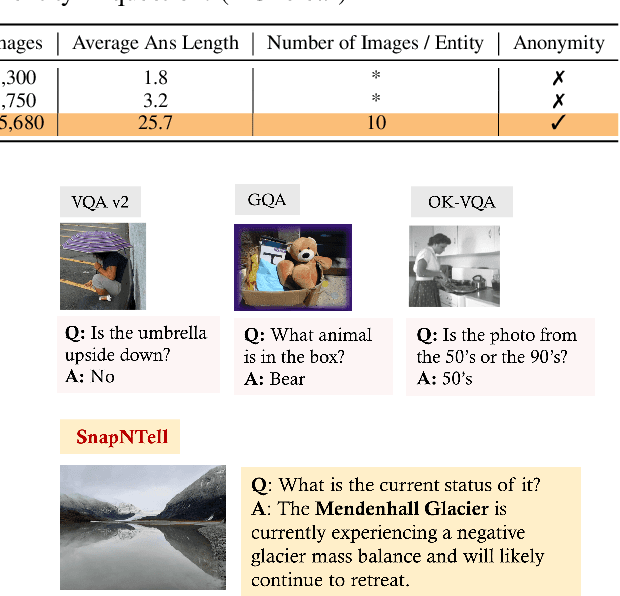
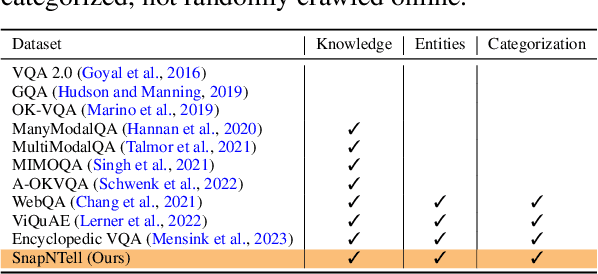
Abstract:Vision-extended LLMs have made significant strides in Visual Question Answering (VQA). Despite these advancements, VLLMs still encounter substantial difficulties in handling queries involving long-tail entities, with a tendency to produce erroneous or hallucinated responses. In this work, we introduce a novel evaluative benchmark named \textbf{SnapNTell}, specifically tailored for entity-centric VQA. This task aims to test the models' capabilities in identifying entities and providing detailed, entity-specific knowledge. We have developed the \textbf{SnapNTell Dataset}, distinct from traditional VQA datasets: (1) It encompasses a wide range of categorized entities, each represented by images and explicitly named in the answers; (2) It features QA pairs that require extensive knowledge for accurate responses. The dataset is organized into 22 major categories, containing 7,568 unique entities in total. For each entity, we curated 10 illustrative images and crafted 10 knowledge-intensive QA pairs. To address this novel task, we devised a scalable, efficient, and transparent retrieval-augmented multimodal LLM. Our approach markedly outperforms existing methods on the SnapNTell dataset, achieving a 66.5\% improvement in the BELURT score. We will soon make the dataset and the source code publicly accessible.
AnyMAL: An Efficient and Scalable Any-Modality Augmented Language Model
Sep 27, 2023



Abstract:We present Any-Modality Augmented Language Model (AnyMAL), a unified model that reasons over diverse input modality signals (i.e. text, image, video, audio, IMU motion sensor), and generates textual responses. AnyMAL inherits the powerful text-based reasoning abilities of the state-of-the-art LLMs including LLaMA-2 (70B), and converts modality-specific signals to the joint textual space through a pre-trained aligner module. To further strengthen the multimodal LLM's capabilities, we fine-tune the model with a multimodal instruction set manually collected to cover diverse topics and tasks beyond simple QAs. We conduct comprehensive empirical analysis comprising both human and automatic evaluations, and demonstrate state-of-the-art performance on various multimodal tasks.
Navigating Connected Memories with a Task-oriented Dialog System
Nov 15, 2022



Abstract:Recent years have seen an increasing trend in the volume of personal media captured by users, thanks to the advent of smartphones and smart glasses, resulting in large media collections. Despite conversation being an intuitive human-computer interface, current efforts focus mostly on single-shot natural language based media retrieval to aid users query their media and re-live their memories. This severely limits the search functionality as users can neither ask follow-up queries nor obtain information without first formulating a single-turn query. In this work, we propose dialogs for connected memories as a powerful tool to empower users to search their media collection through a multi-turn, interactive conversation. Towards this, we collect a new task-oriented dialog dataset COMET, which contains $11.5k$ user<->assistant dialogs (totaling $103k$ utterances), grounded in simulated personal memory graphs. We employ a resource-efficient, two-phase data collection pipeline that uses: (1) a novel multimodal dialog simulator that generates synthetic dialog flows grounded in memory graphs, and, (2) manual paraphrasing to obtain natural language utterances. We analyze COMET, formulate four main tasks to benchmark meaningful progress, and adopt state-of-the-art language models as strong baselines, in order to highlight the multimodal challenges captured by our dataset.
Tell Your Story: Task-Oriented Dialogs for Interactive Content Creation
Nov 08, 2022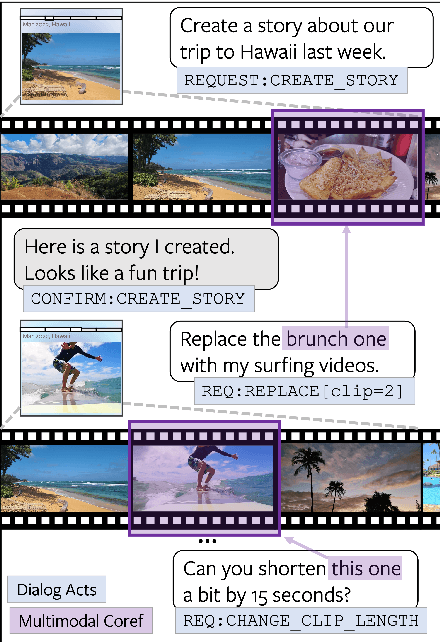
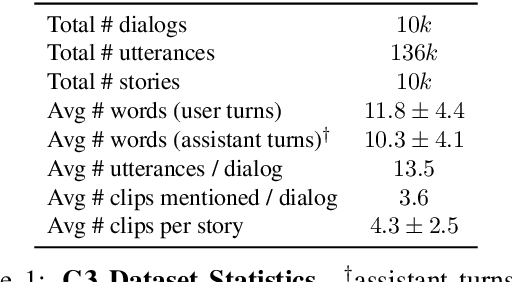


Abstract:People capture photos and videos to relive and share memories of personal significance. Recently, media montages (stories) have become a popular mode of sharing these memories due to their intuitive and powerful storytelling capabilities. However, creating such montages usually involves a lot of manual searches, clicks, and selections that are time-consuming and cumbersome, adversely affecting user experiences. To alleviate this, we propose task-oriented dialogs for montage creation as a novel interactive tool to seamlessly search, compile, and edit montages from a media collection. To the best of our knowledge, our work is the first to leverage multi-turn conversations for such a challenging application, extending the previous literature studying simple media retrieval tasks. We collect a new dataset C3 (Conversational Content Creation), comprising 10k dialogs conditioned on media montages simulated from a large media collection. We take a simulate-and-paraphrase approach to collect these dialogs to be both cost and time efficient, while drawing from natural language distribution. Our analysis and benchmarking of state-of-the-art language models showcase the multimodal challenges present in the dataset. Lastly, we present a real-world mobile demo application that shows the feasibility of the proposed work in real-world applications. Our code and data will be made publicly available.
IMU2CLIP: Multimodal Contrastive Learning for IMU Motion Sensors from Egocentric Videos and Text
Oct 26, 2022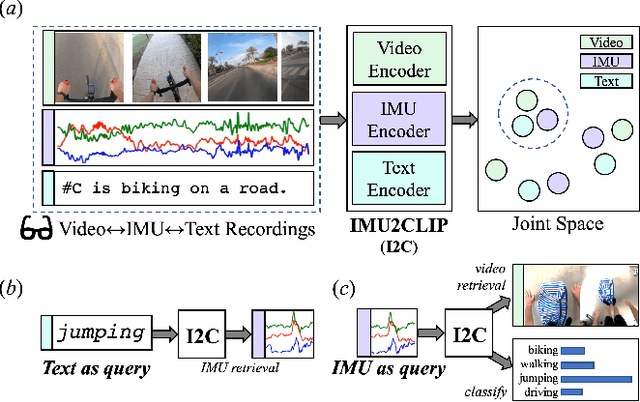
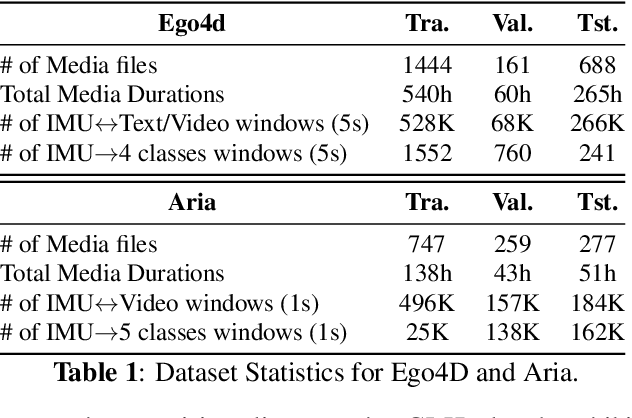
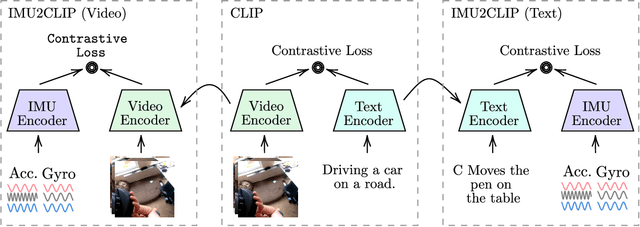

Abstract:We present IMU2CLIP, a novel pre-training approach to align Inertial Measurement Unit (IMU) motion sensor recordings with video and text, by projecting them into the joint representation space of Contrastive Language-Image Pre-training (CLIP). The proposed approach allows IMU2CLIP to translate human motions (as measured by IMU sensors) into their corresponding textual descriptions and videos -- while preserving the transitivity across these modalities. We explore several new IMU-based applications that IMU2CLIP enables, such as motion-based media retrieval and natural language reasoning tasks with motion data. In addition, we show that IMU2CLIP can significantly improve the downstream performance when fine-tuned for each application (e.g. activity recognition), demonstrating the universal usage of IMU2CLIP as a new pre-trained resource. Our code will be made publicly available.
Connecting What to Say With Where to Look by Modeling Human Attention Traces
May 12, 2021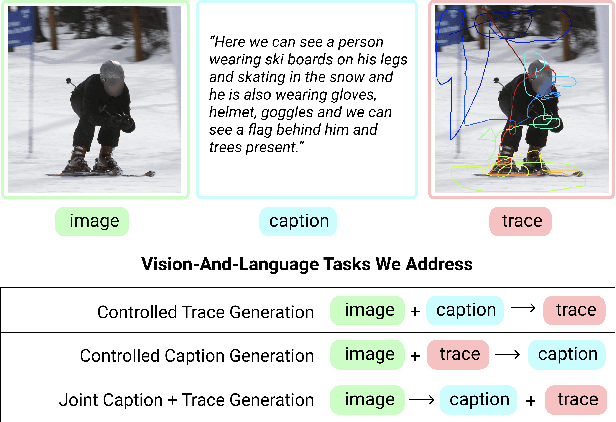



Abstract:We introduce a unified framework to jointly model images, text, and human attention traces. Our work is built on top of the recent Localized Narratives annotation framework [30], where each word of a given caption is paired with a mouse trace segment. We propose two novel tasks: (1) predict a trace given an image and caption (i.e., visual grounding), and (2) predict a caption and a trace given only an image. Learning the grounding of each word is challenging, due to noise in the human-provided traces and the presence of words that cannot be meaningfully visually grounded. We present a novel model architecture that is jointly trained on dual tasks (controlled trace generation and controlled caption generation). To evaluate the quality of the generated traces, we propose a local bipartite matching (LBM) distance metric which allows the comparison of two traces of different lengths. Extensive experiments show our model is robust to the imperfect training data and outperforms the baselines by a clear margin. Moreover, we demonstrate that our model pre-trained on the proposed tasks can be also beneficial to the downstream task of COCO's guided image captioning. Our code and project page are publicly available.
SIMMC 2.0: A Task-oriented Dialog Dataset for Immersive Multimodal Conversations
Apr 18, 2021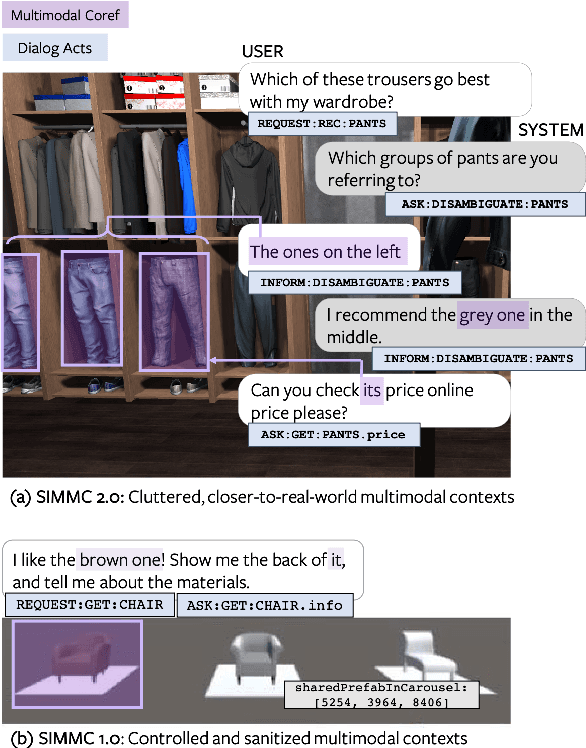



Abstract:We present a new corpus for the Situated and Interactive Multimodal Conversations, SIMMC 2.0, aimed at building a successful multimodal assistant agent. Specifically, the dataset features 11K task-oriented dialogs (117K utterances) between a user and a virtual assistant on the shopping domain (fashion and furniture), grounded in situated and photo-realistic VR scenes. The dialogs are collected using a two-phase pipeline, which first generates simulated dialog flows via a novel multimodal dialog simulator we propose, followed by manual paraphrasing of the generated utterances. In this paper, we provide an in-depth analysis of the collected dataset, and describe in detail the four main benchmark tasks we propose for SIMMC 2.0. The preliminary analysis with a baseline model highlights the new challenges that the SIMMC 2.0 dataset brings, suggesting new directions for future research. Our dataset and code will be made publicly available.
 Add to Chrome
Add to Chrome Add to Firefox
Add to Firefox Add to Edge
Add to Edge